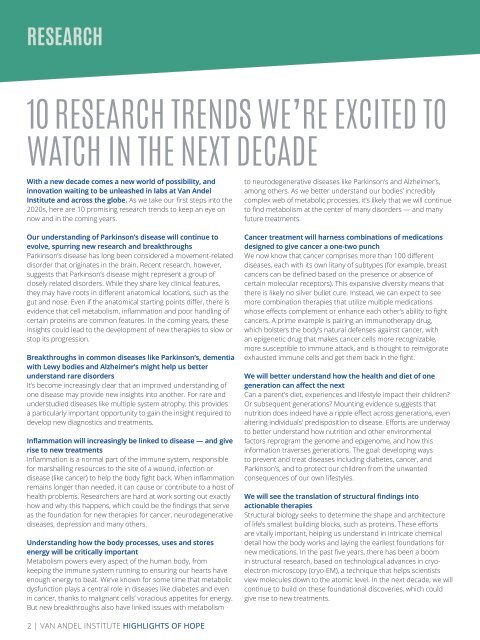2020 Spring/Summer Highlights of Hope
You also want an ePaper? Increase the reach of your titles
YUMPU automatically turns print PDFs into web optimized ePapers that Google loves.
RESEARCH<br />
10 RESEARCH TRENDS WE’RE EXCITED TO<br />
WATCH IN THE NEXT DECADE<br />
With a new decade comes a new world <strong>of</strong> possibility, and<br />
innovation waiting to be unleashed in labs at Van Andel<br />
Institute and across the globe. As we take our first steps into the<br />
<strong>2020</strong>s, here are 10 promising research trends to keep an eye on<br />
now and in the coming years.<br />
Our understanding <strong>of</strong> Parkinson’s disease will continue to<br />
evolve, spurring new research and breakthroughs<br />
Parkinson’s disease has long been considered a movement-related<br />
disorder that originates in the brain. Recent research, however,<br />
suggests that Parkinson’s disease might represent a group <strong>of</strong><br />
closely related disorders. While they share key clinical features,<br />
they may have roots in different anatomical locations, such as the<br />
gut and nose. Even if the anatomical starting points differ, there is<br />
evidence that cell metabolism, inflammation and poor handling <strong>of</strong><br />
certain proteins are common features. In the coming years, these<br />
insights could lead to the development <strong>of</strong> new therapies to slow or<br />
stop its progression.<br />
Breakthroughs in common diseases like Parkinson’s, dementia<br />
with Lewy bodies and Alzheimer’s might help us better<br />
understand rare disorders<br />
It’s become increasingly clear that an improved understanding <strong>of</strong><br />
one disease may provide new insights into another. For rare and<br />
understudied diseases like multiple system atrophy, this provides<br />
a particularly important opportunity to gain the insight required to<br />
develop new diagnostics and treatments.<br />
Inflammation will increasingly be linked to disease — and give<br />
rise to new treatments<br />
Inflammation is a normal part <strong>of</strong> the immune system, responsible<br />
for marshalling resources to the site <strong>of</strong> a wound, infection or<br />
disease (like cancer) to help the body fight back. When inflammation<br />
remains longer than needed, it can cause or contribute to a host <strong>of</strong><br />
health problems. Researchers are hard at work sorting out exactly<br />
how and why this happens, which could be the findings that serve<br />
as the foundation for new therapies for cancer, neurodegenerative<br />
diseases, depression and many others.<br />
Understanding how the body processes, uses and stores<br />
energy will be critically important<br />
Metabolism powers every aspect <strong>of</strong> the human body, from<br />
keeping the immune system running to ensuring our hearts have<br />
enough energy to beat. We’ve known for some time that metabolic<br />
dysfunction plays a central role in diseases like diabetes and even<br />
in cancer, thanks to malignant cells’ voracious appetites for energy.<br />
But new breakthroughs also have linked issues with metabolism<br />
to neurodegenerative diseases like Parkinson’s and Alzheimer’s,<br />
among others. As we better understand our bodies’ incredibly<br />
complex web <strong>of</strong> metabolic processes, it’s likely that we will continue<br />
to find metabolism at the center <strong>of</strong> many disorders — and many<br />
future treatments.<br />
Cancer treatment will harness combinations <strong>of</strong> medications<br />
designed to give cancer a one-two punch<br />
We now know that cancer comprises more than 100 different<br />
diseases, each with its own litany <strong>of</strong> subtypes (for example, breast<br />
cancers can be defined based on the presence or absence <strong>of</strong><br />
certain molecular receptors). This expansive diversity means that<br />
there is likely no silver bullet cure. Instead, we can expect to see<br />
more combination therapies that utilize multiple medications<br />
whose effects complement or enhance each other’s ability to fight<br />
cancers. A prime example is pairing an immunotherapy drug,<br />
which bolsters the body’s natural defenses against cancer, with<br />
an epigenetic drug that makes cancer cells more recognizable,<br />
more susceptible to immune attack, and is thought to reinvigorate<br />
exhausted immune cells and get them back in the fight.<br />
We will better understand how the health and diet <strong>of</strong> one<br />
generation can affect the next<br />
Can a parent’s diet, experiences and lifestyle impact their children?<br />
Or subsequent generations? Mounting evidence suggests that<br />
nutrition does indeed have a ripple effect across generations, even<br />
altering individuals’ predisposition to disease. Efforts are underway<br />
to better understand how nutrition and other environmental<br />
factors reprogram the genome and epigenome, and how this<br />
information traverses generations. The goal: developing ways<br />
to prevent and treat diseases including diabetes, cancer, and<br />
Parkinson’s, and to protect our children from the unwanted<br />
consequences <strong>of</strong> our own lifestyles.<br />
We will see the translation <strong>of</strong> structural findings into<br />
actionable therapies<br />
Structural biology seeks to determine the shape and architecture<br />
<strong>of</strong> life’s smallest building blocks, such as proteins. These efforts<br />
are vitally important, helping us understand in intricate chemical<br />
detail how the body works and laying the earliest foundations for<br />
new medications. In the past five years, there has been a boom<br />
in structural research, based on technological advances in cryoelectron<br />
microscopy (cryo-EM), a technique that helps scientists<br />
view molecules down to the atomic level. In the next decade, we will<br />
continue to build on these foundational discoveries, which could<br />
give rise to new treatments.<br />
2 | VAN ANDEL INSTITUTE HIGHLIGHTS OF HOPE
















